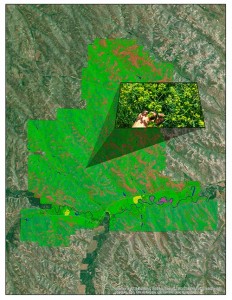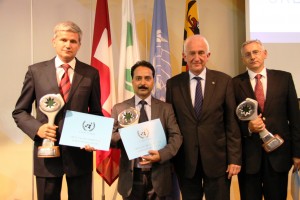See also: Global Resources and the Environment page | Cambridge University Press site
Preface
People often feel anxious when advanced to a new job – when a politician moves to a higher office, a businessman takes on more responsibility, or an athlete turns professional. Over time, they learn to be more comfortable with their new situation and feel less overwhelmed.
The situation itself does not change. Rather, with more detailed knowledge, people learn to organize their tasks in context – what is likely to happen and what is not likely; what is important and needs tending and what is unimportant and can be delayed; and in what sequence things occur.
Many people are becoming anxious over the environmental situation because they are bombarded at a fast pace with a large number of individual facts and assertions but with little overarching context. The purpose of this book is to put the many aspects of the environment, resources, and people into perspective so that readers will feel less overwhelmed.
The book is based on the premise that much in-depth knowledge can be presented simply, thoroughly, and succinctly. People need to learn too many other things to spend too much time on one subject. The intended audience for this book is advancing, mid-career professionals, policymakers, managers, academicians, and anyone else who works with or is interested in environmental/resource issues. Even those with a focus on one issue will benefit from a broader knowledge of the subject as a whole.
The book intends to educate the reader thoroughly but, more importantly, give him/her a perspective as knowledge changes. The book is not intended for skim-reading. The chapters and sections are relatively independent and may be read selectively.
To the academician, the book goes against the trend of increasing specialization. The emphasis on specialization is creating much new knowledge, but it is limiting scientists’ abilities to integrate and understand broad perspectives. The changes in a given resource are generally more affected by changes in other resources than by actions taken by specialists in the target resource.
A hope is that this book will be adopted for graduate courses. Students would need to take several courses to learn about the environmental and resource systems covered in this single volume; they would then have less time to learn more or specialize.
The book is a monograph, not an edited collection of papers. Consequently, we have been forced to deepen our own understanding of each resource and how it interacts with the others and the environment. Economics is not discussed directly but sets the bounds of reasonable futures within which economic solutions can be constructed and debated.
The interactions among the environment, resources, and people are best understood from the perspective of complex, dynamic systems and sustainability, described in the first section of three short chapters. Then nine sections follow, of two to four short chapters each, on people, major environmental systems, and major resources. The environmental systems are climates, landforms, and biodiversity. The resources are water, agriculture, energy, rocks/minerals, and forests. Except for water, aquatic systems are only minimally covered and oceanic resources are not covered at all. Soils are covered as part of landforms. Disturbances have been well studied recently, but are treated as one “change” that is part of dynamic systems – not as a separate subject.
The book’s figures provide more global information subdivided by world regions than can be completely covered in the text. These figures allow the reader to extend his/her understanding of specific regions beyond the text.
Resources and the environment are covered globally because both are global issues; what is done in one part of the world affects all others. Described first are the underlying scientific principles of each resource/environmental topic and what makes each important; then, how it is distributed globally and managed; and finally, what future scenarios and options exist for maintaining, changing, or mitigating them.
The book predicts neither a “gloom and doom” nor a “glowing” environmental/ resource future. The future depends on how people manage the present. The book promotes an informed dialogue about future directions for the world’s environment and resources. It is not a motivational book, but it does not shy away from pointing out obvious “dead ends” and possible actions when analyses lead to such insights.
The book is a result of our common global perspective. It was inspired and informed by the synergies of Chad’s practical experiences and knowledge of resources and Fatma’s analytical perspective and interest in systems theories. More than forty years ago we met and married when Chad was in graduate school at Yale University and Fatma was teaching mathematics at the University of New Haven. Our different backgrounds and perspectives – Chad from a small town in South Carolina, USA, and Fatma from Istanbul, Turkey – have stimulated fascinating discussions ever since. We both enjoy traveling and have done it extensively.
Our travels and discussions with local people have made this book better. As colleagues that we visited in other countries learned of our writing the book, they became excited, offering us various insights, informed discussions, and tours with local resource professionals. Beforehand, we would study the area and frame mentally the resources, environment, and people as a system. Subsequent observations and discussions on the visit would show discrepancies between our mental model and our hosts’, which led to fruitful discussions and learning. It soon because obvious that energy policies affected agriculture as much as agronomists; that the condition of forests was less impacted by forest managers than by agriculture policies; and that water policies were affected strongly by agriculture, energy, and urbanization. Consequently, it became apparent that one needs to understand all resources to make informed decisions.
This book synthesizes existing knowledge, amalgamates different fields, and comes up with intriguing observations. The world’s information is now so vast, complicated, and rapidly changing that many things in this book will no doubt be out of date by the time it reaches print – just as many things changed while writing it. Since the book began about ten years ago, the calculated time of a previous Ice Age (not the present one) was changed by over 100 million years; and the time when North and South America joined has been adjusted by a few million years. A colleague at Yale who showed very scientifically why Neanderthals could never breed with Homo sapiens sapiens has been proven wrong. Locations of different landforms are inconsistent among authorities. This is, and will be, the future of science: no person or generation has perfect knowledge. The future will be about learning details, synthesizing, comparing, measuring, and experimenting; forming thoughtful, flexible mental models; and continuing to learn from and adjust them.
We have tried to use the latest, most accurate data. Some things reported earlier have not been updated with new data. Some recent data have not been consistently posted. Sometimes, an analysis with new data would take too long and would not show meaningful differences. Consequently, sometimes trends that are several years old are shown. Copious online data sets were used. Some of the data is imperfect or incomplete; however, it is preferable to err by commission and use imperfect data rather than to err by omission, for two reasons:
- Out of respect for people who need to make decisions, we prefer to state an educated observation, rather than shy away on the basis of imperfect knowledge or data. Sometimes the data shortcomings are pointed out.
- Fatma’s experience with data sets as an engineer has shown that the best way to improve data is to use it.
Hopefully, the reader will appreciate the dynamic nature of knowledge and use this book as a basis to adjust from, rather than as a static authority.
We also hope that environmental and resource knowledge will become more integrative and holistic. This book is designed to encourage that trend.
All units are metric.



